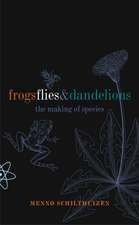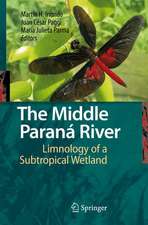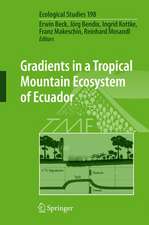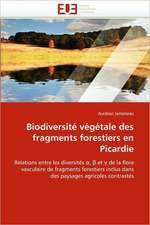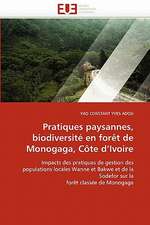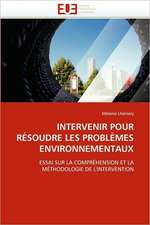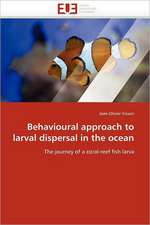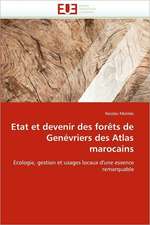The Loom of Life: Unravelling Ecosystems
Autor Menno Schilthuizenen Limba Engleză Hardback – 28 aug 2008
The strength of this book is that it will help digest some of these more complex issues in the ecology of biodiversity. It will do this by zooming out from the local scale to the global scale in a number of steps, marrying community ecology with macroecology, and introducing unexpected nuggets of natural history along the way. The reader will notice that, the larger the scale, the more the familiar niche-concept appears to be overshadowed by exotic fields from fractal and complexity theory. However, scientists differ in opinion on the scale at which niches become irrelevant. These differences of opinion, but also the search for unified ecological theories, will form another force by which the story will be carried along to its conclusion. A conclusion which, surprisingly, seeks to find a glimpse of the globe's future in the traces from its past.
Preț: 938.04 lei
Preț vechi: 1143.94 lei
-18% Nou
Puncte Express: 1407
Preț estimativ în valută:
179.49€ • 187.91$ • 148.52£
179.49€ • 187.91$ • 148.52£
Carte tipărită la comandă
Livrare economică 05-19 aprilie
Preluare comenzi: 021 569.72.76
Specificații
ISBN-13: 9783540680512
ISBN-10: 3540680519
Pagini: 184
Ilustrații: XVI, 168 p. 14 illus.
Dimensiuni: 155 x 235 x 20 mm
Greutate: 0.39 kg
Ediția:2008
Editura: Springer Berlin, Heidelberg
Colecția Springer
Locul publicării:Berlin, Heidelberg, Germany
ISBN-10: 3540680519
Pagini: 184
Ilustrații: XVI, 168 p. 14 illus.
Dimensiuni: 155 x 235 x 20 mm
Greutate: 0.39 kg
Ediția:2008
Editura: Springer Berlin, Heidelberg
Colecția Springer
Locul publicării:Berlin, Heidelberg, Germany
Public țintă
Professional/practitionerDescriere
In an age of increasing environmental problems, ecology has had to grow up fast from a discipline dealing with relatively simple interactions between species to one that tries to explain changes in global patterns of diversity and richness. The issues are complex. Every species may seem to have its own unique role, but if that is true, then why are there hundreds of species of plankton in an ecosystem with only a handful of niches? The tropics have a high biodiversity, but does anybody know why? And how can a single introduced tree species wreak havoc in Hawaii’s rainforests, when it is one of thousands of quietly coexisting tree species in its native continent, South America?
The strength of this book is that it will help digest some of these more complex issues in the ecology of biodiversity. It will do this by zooming out from the local scale to the global scale in a number of steps, marrying community ecology with macroecology, and introducing unexpected nuggets of natural history along the way. The reader will notice that, the larger the scale, the more the familiar niche-concept appears to be overshadowed by exotic fields from fractal and complexity theory. However, scientists differ in opinion on the scale at which niches become irrelevant. These differences of opinion, but also the search for unified ecological theories, will form another force by which the story will be carried along to its conclusion. A conclusion which, surprisingly, seeks to find a glimpse of the globe's future in the traces from its past.
The strength of this book is that it will help digest some of these more complex issues in the ecology of biodiversity. It will do this by zooming out from the local scale to the global scale in a number of steps, marrying community ecology with macroecology, and introducing unexpected nuggets of natural history along the way. The reader will notice that, the larger the scale, the more the familiar niche-concept appears to be overshadowed by exotic fields from fractal and complexity theory. However, scientists differ in opinion on the scale at which niches become irrelevant. These differences of opinion, but also the search for unified ecological theories, will form another force by which the story will be carried along to its conclusion. A conclusion which, surprisingly, seeks to find a glimpse of the globe's future in the traces from its past.
Cuprins
Life in Little Worlds.- Leaky Buckets.- Hidden Riches.- No Niche Like Home.- Neutral by Nature.- In Splendid Isolation.- Ecology of Wildcards.- The Loom Of Life.- The Age of Atropos.
Recenzii
From the reviews:
"Evolutionary biologist and science writer Menno Schilthuizen retells the story of the Wilson-Simberloff experiment at some length in The Loom of Life. His book is a readable, anecdotal introduction to the ecology of diversity, addressing basic questions about why there are so many different species and why some species are rare and others common. … The Loom of Life is useful. … might read this slender book for a bearing on how to tackle environmental problems." (Emma Marris, Nature, Vol. 455 (30), 2008)
"In this enjoyable book, evolutionary biologist Schilthuizen … conveys his love of natural ecosystems and species diversity. Schilthuizen covers great spans of time and geography in an effort to explain some epic questions including how ecosystems function, what factors contribute to determining biodiversity, and how theories develop and change over time. … for those interested in learning about the intricacies of ecosystem ecology, The Loom of Life is well worth reading. Summing Up: Highly recommended. All academic, professional, and general collections." (D. Goldblum, Choice, Vol. 46 (8), April, 2009)
"Evolutionary biologist and science writer Menno Schilthuizen retells the story of the Wilson-Simberloff experiment at some length in The Loom of Life. His book is a readable, anecdotal introduction to the ecology of diversity, addressing basic questions about why there are so many different species and why some species are rare and others common. … The Loom of Life is useful. … might read this slender book for a bearing on how to tackle environmental problems." (Emma Marris, Nature, Vol. 455 (30), 2008)
"In this enjoyable book, evolutionary biologist Schilthuizen … conveys his love of natural ecosystems and species diversity. Schilthuizen covers great spans of time and geography in an effort to explain some epic questions including how ecosystems function, what factors contribute to determining biodiversity, and how theories develop and change over time. … for those interested in learning about the intricacies of ecosystem ecology, The Loom of Life is well worth reading. Summing Up: Highly recommended. All academic, professional, and general collections." (D. Goldblum, Choice, Vol. 46 (8), April, 2009)
Notă biografică
The author (born in 1965) is a Dutch biologist and science writer with a doctorate from Leiden University. In 2001, he published Frogs, Flies and Dandelions, an Oxford University Press trade book on speciation, which was favourably reviewed in Nature and in Trends in Ecology and Evolution, and translated into French, Dutch and Greek. The author writes news stories and feature articles on ecology and evolution for New Scientist, Natural History, Science, and various national newspapers in Belgium, the Netherlands and Malaysia. From 2000 to 2006, he was an associate professor in the Institute for Tropical Biology and Conservation in Malaysian Borneo. Since 2007, he has been director of research at the National Museum of Natural History in Leiden, the Netherlands. He has published about 55 scientific papers on tropical ecology, systematics and evolutionary biology, mostly involving land snails and insects.
Textul de pe ultima copertă
How can thousands of tree species coexist in a patch of tropical rainforest where there seem to be just a handful of niches? Why does biodiversity boom at the equator and plummet at the poles? Questions like these are central to modern ecology, where the gap between the familiar "niche" and the staggering (but sharply decreasing) global biodiversity seems to become ever wider. This book helps students and the general reader to bridge that gap, by tip-toeing from the smallest to the largest ecosystems.
Caracteristici
Helps to understand some of the more complex issues in the ecology of biodiversity by zooming out from the local scale to the global scale
Seeks to find a glimpse of the globe's future in ecologists' field experiments
Helps to digest difficult concepts in a pleasant and readable manner
Seeks to find a glimpse of the globe's future in ecologists' field experiments
Helps to digest difficult concepts in a pleasant and readable manner


